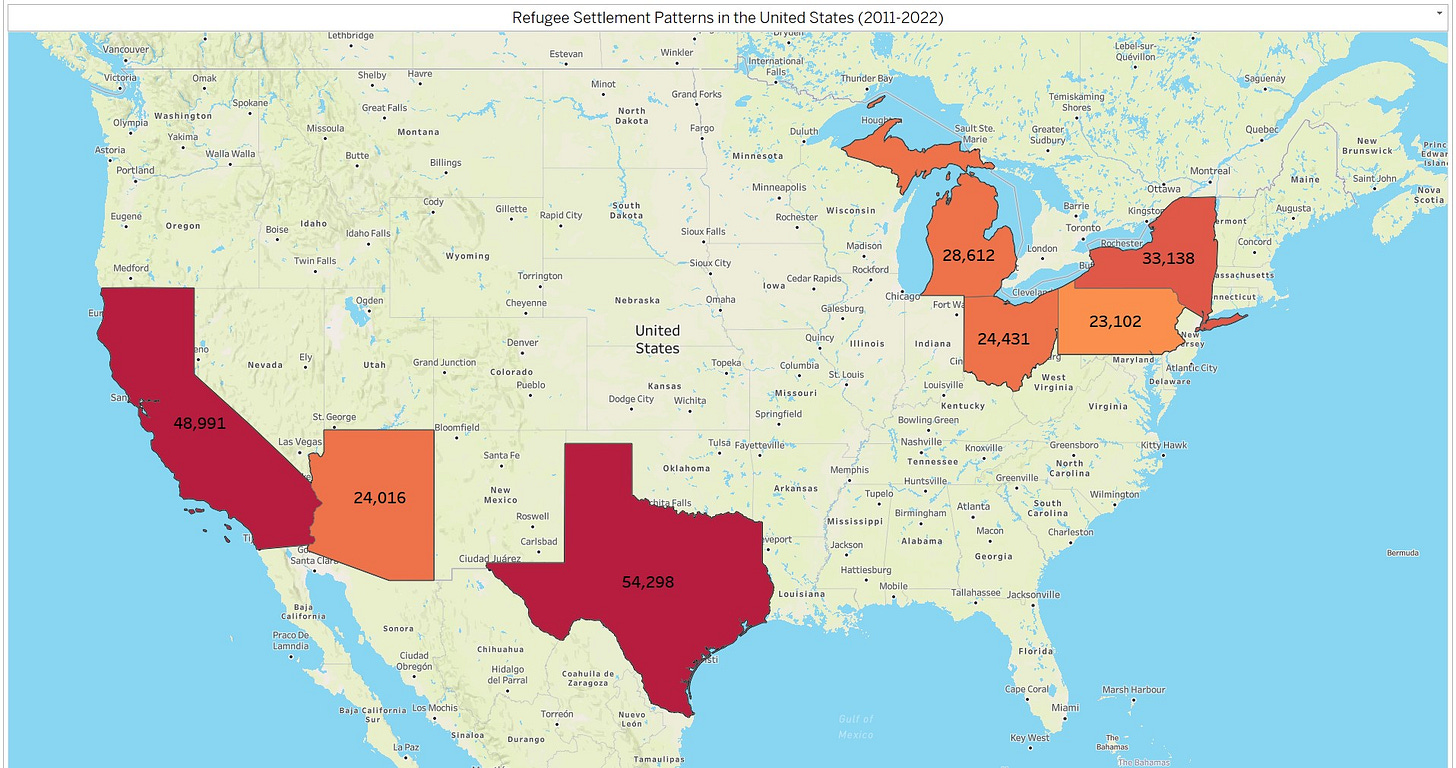
Are the people crossing the southern border refugees? What can we do about that?
There’s some additional context we didn’t address last week. What’s the difference between an immigrant and a refugee, and why is the difference significant?
Immigrants choose to relocate to another country. They move voluntarily, seeking better living conditions, economic opportunities, and family reunification. Immediate threats to their safety do not drive their move. To achieve the ability to relocate, they apply for visas or residency permits. They must meet specific criteria the destination country sets, including financial stability, employment, family ties, or skills. Immigrants have no international legal protections.
Refugees flee their home country due to persecution, war, or violence. Escaping threats to their lives or freedom compels them to leave. International law protects refugees. This law obligates host countries to provide certain rights and not return them to a country where they face severe threats to their life or freedom. They receive assistance from governments, international organizations, and nonprofits in their resettlement process, including help with housing, language training, employment, and access to social services.
The United States Senate approved the 1967 Protocol Relating to the Status of Refugees with no senators objecting under Record Vote No: 317 on October 4, 1968. The United States declared two grievances when it ratified the treaty, one related to taxation of the refugees and the other associated with Social Security.
President Lyndon B. Johnson (D) ratified the treaty on November 1, 1968.
The 96th Congress passed the Refugee Act of 1980 to further codify our commitment to refugee law. President Jimmy Carter (D) signed the act into law on March 17, 1980. This law authorized the President, in consultation with Congress, to set an annual ceiling on the number of refugees admitted to the US. It further led to the creation of the Office of Refugee Resettlement (ORR) within the US Department of Health and Human Services to oversee the implementation of refugee resettlement programs.
We have some illegal immigration at the southern border. But mostly, we have a refugee challenge.
Many individuals from Central and South America who come to the US border flee their countries due to violence, threats from gangs, political instability, or persecution. The US accepts some of these individuals as refugees. While many seek asylum, the US doesn’t grant all asylum seekers refugee status. The refugee determination process involves individual case assessments, and outcomes vary by individual. The number of refugees the US accepts per region per year changes with each presidential administration.
The United States committed to adhering to the laws and principles outlined in the agreement by agreeing to and ratifying the Protocol Relating to the Status of Refugees. These principles are:
Non-Refoulement: The US agreed to ensure that refugees are not expelled or returned to countries where they face threats to their lives or freedom because of their race, religion, nationality, membership in a particular social group, or political opinion.
No Penalties for Illegal Entry: The US agreed not to penalize refugees for their illegal entry if they come directly from a territory where they faced threats to their lives or freedom and they present themselves without delay to the authorities.
Access to Courts: The US agreed that refugees should have access to the courts on par with nationals.
Right to Work: The US agreed that refugees have the right to work and to the same treatment as nationals regarding employment laws and conditions.
Welfare Access: The US agreed refugees should have access to social welfare equivalent to that of nationals of the host country.
In sum, the immigrant and refugee difference presents a multifaceted issue. While there is illegal immigration, much of the border crisis involves refugees. These are people fleeing extreme violence, persecution, or political instability, primarily from Central and South America.
This complex mix of illegal immigration and legitimate refugee movement presents unique challenges. On one hand, there is a need for robust border security to manage unlawful entry. On the other, there is a US-ratified refugee treaty commitment that protects and provides assistance to those who qualify as refugees under international law.
We need a nuanced approach that goes beyond the black-and-white classification of migrants and illegal immigrants and recognizes the grey reality of individuals arriving at the border. In essence, our response at the border needs to balance enforcing immigration laws with our obligations towards those seeking refuge from life-threatening situations.
Another point to consider is the distribution of refugee resettlement across states. Let’s consider the period from 2011 to 2022. During this time, seven states consistently emerged as primary destinations for refugees. Some states, specifically Florida and Washington, were among the top destinations in less than half of these years. No other states appeared on the list.

Depicting the data on a map is enlightening. The map clearly shows this issue isn’t a blue-state or red-state issue. This is a geography issue.
Refugees enter the US and then settle in their state of arrival, which means border states have more refugees. It further highlights the southern border receives more refugees than the northern border. The darker colors on the map indicate more refugees made those states a place of permanent residence.
We need to take some of the refugee burden off US border states.
Further, when we reject refugees legally, they still come into the country. Illegal entry across borders increases, along with human trafficking and other illicit activity. According to the Cato Institute, the US Border Patrol “recorded 41 percent more successful illegal entries in fiscal year 2019 than in 2016 and was on pace for 47 percent more through four months of 2020.” These refugees still settled in the US but with unknown numbers and locations. Undocumented and uncertain numbers of individuals then challenge state and local governments by making it difficult to plan and provide necessary services for residents and refugees.
The US Department of Homeland Security (DHS) leads refugee and immigration activities. Inside DHS, US Citizenship and Immigration Services (USCIS) leads the refugee admission process, including conducting interviews and determining refugee status. Other DHS agencies, including Customs and Border Protection (CBP) and Immigration and Customs Enforcement (ICE), play significant roles in managing border security and immigration enforcement.
Last week, we considered whether it was appropriate to send US military troops to the border for law enforcement. That option wasn’t tenable for both legal and practical reasons. However, there is no limitation on sending US forces to the border for humanitarian assistance.
Second consideration: Send troops to the border for humanitarian assistance
We need to increase DHS’s capacity to manage the refugee status at the southern border. We do need strong security measures against illegal entry. At the same time, we must provide humanitarian aid and support for refugees at the border, including healthcare, shelter, and legal assistance. Turning away all refugees only increases illegal entry. Instead, we need to make our process systematic and efficient.
We need to increase this capacity in a manner that takes some of the burden off US border states—processing refugees and allowing them to settle at a place of their choosing and with no assistance results in the majority of them settling in a border state. Additional states could help our border states rather than letting Texas, California, and New York absorb them all.
Though DHS leads refugee and immigration activities, the US military can provide nearly instant capability to address the issue. The military frequently engages in humanitarian and disaster relief operations domestically. This mission area in the Department of Defense is called Defense Support of Civil Authorities (DSCA). DSCA includes rescue operations, medical assistance, and logistical support. DSCA may further include disaster relief, emergency management, and other forms of assistance where the military’s capabilities are beneficial. The key aspect of DSCA is that it supports civilian authorities and the military acts in a supporting rather than a lead role.
Led by DHS, DoD could help establish semi-permanent refugee and immigration processing centers on the border, while also providing logistical assistance to refugees to take them beyond our US border states to settle.
This approach achieves several goals. It addresses immediate humanitarian needs and proposes a more equitable distribution of refugees nationwide. It alleviates the disproportionate impact on border states and contributes to a more systematic and efficient refugee processing system.
It encourages refugees and immigrants alike to attempt to enter the country legally. It dissuades human trafficking and other illicit entry into the country, giving unambiguous indications to law enforcement agents that other attempts to enter the nation are unlawful.
In sum, this approach aims to encourage legal entry, reduce illicit activities, and ease the operational load on border states, thereby addressing both humanitarian needs and border security concerns.
What are the most effective and humane strategies to solidify our borders against illegal entry?
Immigrants choose to relocate to another country. Refugees flee their home country due to persecution, war, or violence. The immigrant and refugee difference presents a multifaceted issue. While we have illegal immigration, much of the border crisis involves refugees.
On the one hand, we need robust border security to manage unlawful entry. On the other, the US ratified a refugee treaty, committing to protecting and providing assistance to those who qualify as refugees under international law.
And we need to take some of the refugee burden off our US border states.
To achieve our multifaceted goal, we need to increase the Department of Homeland Security’s capacity to manage the refugee situation at the southern border. We need to augment this capacity in a manner that takes some of the burden off US border states. By leveraging the Department of Defense’s support of civil authorities role, we can improve medical assistance, logistical support, and disaster relief on the border. We can then support our border states by distributing refugees more equitably nationwide.
Next week, strengthening border security measures by reducing the demand for migration. I look forward to you joining me.
May God bless the United States of America.















Share this post